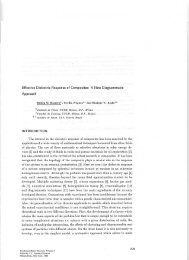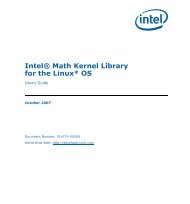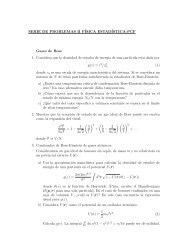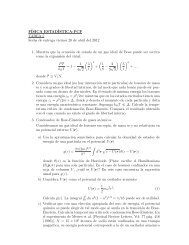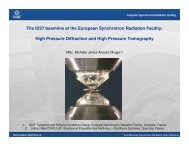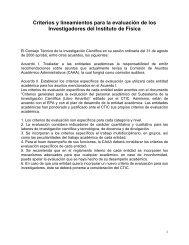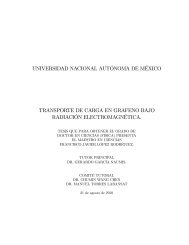Surface Plasmons on Metal Nanoparticles - UNAM
Surface Plasmons on Metal Nanoparticles - UNAM
Surface Plasmons on Metal Nanoparticles - UNAM
Create successful ePaper yourself
Turn your PDF publications into a flip-book with our unique Google optimized e-Paper software.
3808 J. Phys. Chem. C, Vol. 111, No. 10, 2007 Noguezrepresentati<strong>on</strong>, finite differences methods, etc. 46 Once a numericalmethod is chosen, it is important to select a “realistic”dielectric functi<strong>on</strong> that better resembles the material propertiesof the system, in this case, particles of nanometric sizes. Here,we show the main characteristics that a realistic dielectricfuncti<strong>on</strong> should have to calculate the light extincti<strong>on</strong> of NPs.A. Nanoparticle Dielectric Functi<strong>on</strong>. As starting point, wecan employ dielectric functi<strong>on</strong>s measured experimentally forbulk metals, ɛ exp (ω). These dielectric functi<strong>on</strong>s have c<strong>on</strong>tributi<strong>on</strong>sfrom interband (inter) and intraband (intra) electr<strong>on</strong>transiti<strong>on</strong>s, which we can assume are additiveɛ exp (ω) ) ɛ inter (ω) + ɛ intra (ω) (2)Interband c<strong>on</strong>tributi<strong>on</strong>s are due to electr<strong>on</strong> transiti<strong>on</strong>s fromoccupied to empty bulk bands separated by an energy gap. Theelectr<strong>on</strong>s are bound by a restoring force given by the energydifference between ground and excited electr<strong>on</strong>ic states inmetals, usually at the ultra violet (UV) regi<strong>on</strong>. 41 Intrabandc<strong>on</strong>tributi<strong>on</strong>s come from electr<strong>on</strong> transiti<strong>on</strong>s at the Fermi levelin incompletely filled bands, or when a filled band overlaps inenergy with an empty band. These transiti<strong>on</strong>s also provide anabsorpti<strong>on</strong> mechanism but at lower energies. Electr<strong>on</strong>s at theFermi level in metals are excited by phot<strong>on</strong>s of very smallenergies, such that, they are essentially “free’’ electr<strong>on</strong>s. Thec<strong>on</strong>tributi<strong>on</strong>s from free electr<strong>on</strong>s to ɛ exp (ω) can be describedby the Drude model 41ω p2ɛ intra (ω) ) 1 -ω(ω + i/τ)where ω p is the plasma frequency and 1/τ the damping c<strong>on</strong>stantdue to the dispersi<strong>on</strong> of the electr<strong>on</strong>s. For most metals at roomtemperature, 1/τ is much less than ω p , and the plasma frequencyfor metals is usually in the visible and UV regi<strong>on</strong>s, with energiespω p from 3 to 20 eV. The theoretical values of ω p can disagreefrom those obtained experimentally, since the c<strong>on</strong>tributi<strong>on</strong> fromthe b<strong>on</strong>d electr<strong>on</strong>s or interband transiti<strong>on</strong>s is not c<strong>on</strong>sidered inthe Drude model. In fact, the b<strong>on</strong>d electr<strong>on</strong>s create a positivebackground that screens the free electr<strong>on</strong>s and ω p is usuallypulled down. For instance, the Drude model predicts for silvera plasma frequency to be 9.2 eV, 41 but the measured <strong>on</strong>e isactually 3.9 eV. 49The collisi<strong>on</strong> time τ determines a characteristic distance λ τ ,which plays a fundamental role in the theory of electr<strong>on</strong>c<strong>on</strong>ducti<strong>on</strong>. An electr<strong>on</strong> picked at random at a given momentwill, <strong>on</strong> average, travel a distance λ τ before its next collisi<strong>on</strong>.This distance λ τ is also known as the mean free path of electr<strong>on</strong>s,and at room temperatures is of the order of few nanometers.Here, we are interested in small NPs mostly at room temperature;hence, we have to c<strong>on</strong>sider that electr<strong>on</strong>s can be alsodispersed by the NP surface, because the free electr<strong>on</strong>’s meanfree path is now comparable or larger than the dimensi<strong>on</strong> ofthe particle. Therefore, it is necessary to include an extradamping term τ(a) toɛ exp (ω), due to the surface scattering ofthe “free’’ electr<strong>on</strong>s. The surface dispersi<strong>on</strong> not <strong>on</strong>ly depends<strong>on</strong> the particle size, but also <strong>on</strong> its shape. 50To include surface dispersi<strong>on</strong> we need modify the intrabandc<strong>on</strong>tributi<strong>on</strong>s by changing the damping term. From eq 2, weobtain the input of the bound charges by subtracting the freeelectr<strong>on</strong> c<strong>on</strong>tributi<strong>on</strong> from the bulk dielectric functi<strong>on</strong>. The freeelectr<strong>on</strong> c<strong>on</strong>tributi<strong>on</strong>s are calculated with Drude and using thetheoretical values of ω p . Now, we include the surface dampingby adding the extra damping term τ(a) to the Drude model.Finally, we obtain a dielectric functi<strong>on</strong>, which also depends <strong>on</strong>(3)Figure 1. Interband c<strong>on</strong>tributi<strong>on</strong>s to the dielectric functi<strong>on</strong> of bulksilver.the NP size, and includes the c<strong>on</strong>tributi<strong>on</strong>s of (i) the freeelectr<strong>on</strong>s, (ii) surface damping, and (iii) interband transiti<strong>on</strong>sor bound electr<strong>on</strong>s, given byɛ(ω, a) ) ɛ inter (ω) + ɛ NP intra (ω, a)) {ɛ exp (ω) - ɛ intra (ω)} +{2ω p1 -ω(ω + i/τ + i/τ(a))} (4)In this work, we will c<strong>on</strong>sider for all the cases the surfacedispersi<strong>on</strong> of a sphere of radius a given by 1/τ(a) )V f /a, 51 whereV f is the Fermi velocity of the electr<strong>on</strong> cloud. The smaller theparticle, the more important is the surface dispersi<strong>on</strong> effect. Laterwe will show that surface dispersi<strong>on</strong> effects do not change thelocati<strong>on</strong> of the surface modes, but they affect the coupling ofsuch proper modes with the applied field, making the res<strong>on</strong>ancepeaks wider and less intense. 18In Figure 1, we show the interband or bound electr<strong>on</strong>s inputto the bulk dielectric functi<strong>on</strong> of silver as measured by Johns<strong>on</strong>and Christy, 49 according to eq 2, and using Drude to model theintraband input. The main c<strong>on</strong>tributi<strong>on</strong> to the imaginary part ofɛ inter (ω) is at wavelengths below 325 nm, whereas for largerwavelengths, the input is almost nil. On the other hand, thec<strong>on</strong>tributi<strong>on</strong>s to the real part are always different from zero,being the most significant at about 315 nm, while between 350and 700 nm the real part is almost c<strong>on</strong>stant. We should keep inmind that interband electr<strong>on</strong> transiti<strong>on</strong>s will absorb energy, butnot c<strong>on</strong>tribute to SPRs.Once the NP’s dielectric functi<strong>on</strong> is determined, we have tochoose a method to find the SPRs. In this work, we employ thespectral representati<strong>on</strong> formalism and the discrete dipole approximati<strong>on</strong>(DDA). In secti<strong>on</strong> III, we introduce the mainc<strong>on</strong>cepts of the spectral representati<strong>on</strong> formalism, and in secti<strong>on</strong>sIV and VI, we employ it to study the SPRs of ellipsoidal NPs,as well as supported NPs and 1D chains. For the case ofsuspended polyhedral NPs, we employ DDA, which is a wellsuited technique for studying scattering and absorpti<strong>on</strong> ofelectromagnetic radiati<strong>on</strong> by particles of arbitrary shapes withsizes of the order or less than the wavelength of the incidentlight. 52 For a more complete descripti<strong>on</strong> of DDA and itsnumerical implementati<strong>on</strong>, DDSCAT, the reader can c<strong>on</strong>sultrefs 17 and 53-56.B. Large <strong>Nanoparticles</strong> versus Small <strong>Nanoparticles</strong>. Theimportance of the absorpti<strong>on</strong> and scattering process as a functi<strong>on</strong>of the particle size can be studied for spherical particles usingthe Mie theory, see for example ref 18. It was found that for




